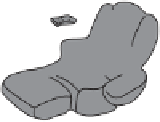Information Technology Reference
In-Depth Information
The first factor is the intended purpose of the copying. Since the purpose is private,
not commercial, time shifting should be seen as fair use with respect to the first factor.
The second factor is the nature of the copied work. Consumers who are time shifting
are copying creative work. This would tend to weigh against a ruling of fair use.
The third factor is the amount of material copied. Since a consumer copies the entire
work, this weighs against a ruling of fair use.
The final factor is the effect time shifting will have on the market for the work. The
Court determined that the studios were unable to demonstrate that time shifting had
eroded the commercial value of their copyrights. The movie studios receive large fees
from television stations in return for allowing their movies to be broadcast. Television
stations can pay these large fees to the studios because they receive income from adver-
tisers. Advertising rates depend upon the size of the audience; the larger the audience,
the more a television station can charge an advertiser to broadcast a commercial. Time
shifting allows people who would not ordinarily be able to watch a show to view it later.
Hence it can be argued that VCRs actually increase the size of the audience, and since
audience size determines the fees studios receive to have their movies broadcast on tele-
vision, it is not at all clear whether the copying of these programs harms the studios.
The Supreme Court ruled, in a 5-4 decision, that time shifting television programs
is a fair use of the copyrighted materials [36]. It said that the private, noncommercial use
of copyrighted materials ought to be presumed fair use unless it could be shown that the
copyright holder would be likely to suffer economic harm from the consumer's actions
(Figure 4.6). Importantly, the Court also noted that the Sony Betamax VCR could be
used to copy both copyrighted and noncopyrighted material, and that Sony should not
be held accountable if some of the people who buy a VCR choose to use it to infringe on
copyrights.
Watch later
Record
Hold
Hold
Fair Use
Commercial
showing
Not Fair Use
FIGURE 4.6
The Supreme Court ruled that videotaping television broadcasts for private
viewing at a later time is fair use of the copyrighted material. This practice is called time
shifting. Using videotaped material for a commercial purpose is not considered fair use.













